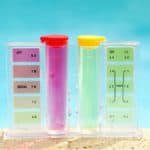Cleaning and maintaining your pool is fundamental to keeping it in the best condition possible.
However, if you’re new to sanitizing your pool you might be curious to know: How long after adding chlorine can you swim?

In this article, I will cover some important information about adding chlorine to your pool, including how long after adding chlorine can you swim.
Keep reading to find out more.
How long after adding chlorine can you swim?
Your safety is the most important factor to consider when you’re cleaning your pool. However, there isn’t a one size fits all rule for how long to wait to swim after adding chemicals to your pool.
When you’re dealing with strong chemicals such as chlorine, it’s important to follow the guidelines provided by the manufacturer to ensure that you’re being as safe as possible.
Depending on how much you have added and the size of your pool, it is generally safe to wait about 4 hours after adding liquid chlorine or until levels reach 5 ppm or lower.
To ensure that the chlorine levels are safe, it’s always important to retest the water before getting back into the pool.
The chemicals in your pool can either keep it clean or make it potentially dangerous. Testing your water is the only way to know for sure what those chemicals are doing in your pool water.
Regular testing is essential for the chlorine, alkalinity, and pH levels of your pool water. Test strips are an accurate and easy way to test the water in your pool. However, first you will need to gather a sample:
Gather a water sample
Step one: Gather a small container for your water sample.
Step two: Push the container into the water, well below the surface. Keep it facing the bottom, as you want air trapped inside of it at this point.
Step three: Turn your hand below the surface, so that the air escapes and pull the container out of the water upright.
Test your pool water with test strips
Step one: Take one test strip, dip it into the water sample and remove it.
Step two: Hold your test strip level test dots up, or place it on a level surface. Follow the instructions on the back of the packaging and wait for the recommended time.
Step three: Match up the colors on the strip to the colors on the packaging.
Testing your water is a good way of ensuring that you’re safe, and will also provide you with peace of mind if you’re unsure of when the pool is safe to swim in again.
Why should you wait to swim after adding chlorine to your pool?
The reason you should wait to swim after adding chlorine to your pool is that it is a strong chemical and being exposed to high levels of it can be dangerous for you as a swimmer.
Too much chlorine can affect your health and the exposure to over-chlorinated water may cause conditions such as asthma, long irritation and even skin and eye irritation.

In addition to this, high chlorine levels lower the pH of the pool water, which becomes more acidic and may affect the pool itself.
A good rule of thumb to follow is that swimmers should wait for a full cycle of the filter before they even think about entering the pool.
If you’re at all anxious or worried about swimming in the pool after chlorine has been added, then wait 24 hours or do a test strip before you get back in the pool.
How long do you have to wait to swim after shocking your pool?
Pool shock refers to a granular oxidizer, a powdered form of chlorine that is used for pool water treatment.
Pools are shocked to keep the water healthy and clean by removing algae and bacteria after frequent use or contamination events.
The process of pool shocking means adding chlorine or non-chlorine shock to your pool. The term ‘shocking’ means to add enough chemicals to the pool or spa water to destroy all combined chlorine present in the water.
The goal of shocking your pool is to raise “free chlorine” levels to a point that destroys unwanted contaminants, such as bacteria, algae, and chloramines.
Shocking is a crucial step in pool maintenance, however, it can be tricky to know how long to wait to swim after shocking your pool.
Generally speaking, it is safe to swim once your chlorine levels are around 5 ppm or after 24 hours have passed.
As I mentioned above, it’s also important to test the water if you’re on a tight schedule and want to know if you can use the pool before the 24 hour mark has passed.
There are a variety of different chemicals that can be used for shocking your pool.
Chemicals used as pool shock
Calcium Hypochlorite - Calcium Hypochlorite, often known as cal-hypo for short, is the most powerful and fast-acting shock available. It is available in 65% and 73% strength, pH level of 12, and is not stabilized.
Sodium Dichlor - Sodium Dichlor is stabilized pool shock, with cyanuric acid as protection from the sun.
Sodium Hypochlorite - Sodium Hypochlorite, also known as bleach or liquid shock, is a heavy-duty type of pool shock that isn’t generally used in home pools. Rather, it is often used in commercial pools in hotels, gyms and pool clubs.
Potassium Monopersulfate (Non-Chlorine Shock) - Potassium monopersulfate, or MPS, is a chlorine alternative oxygen-based shock type. A MPS shock can be used to oxidize, destroy contaminants and help chlorine operate more efficiently.
In summary
When cleaning your pool, your safety is the most important factor to take into consideration. You should wait at least 4 hours or until levels reach 5 ppm or lower before you go swimming.
As a general rule, swimmers should wait for a full cycle of the filter before they even think about entering the pool.
For peace of mind, you should regularly test the water after you have added chlorine and other chemicals to your pool.









